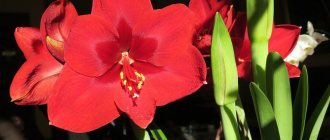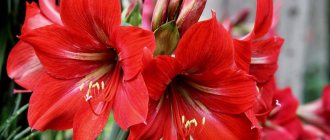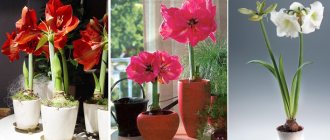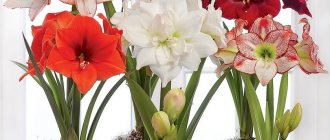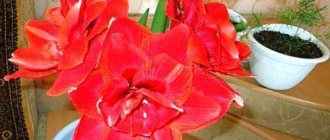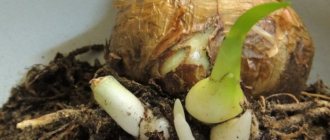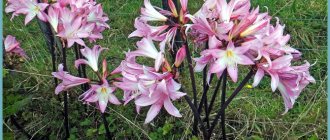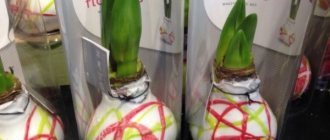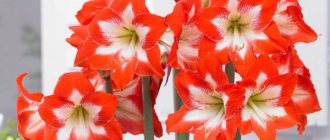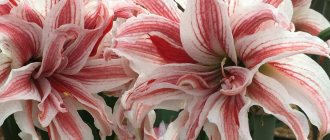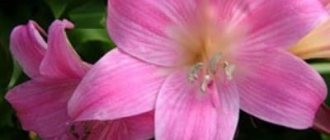Amaryllis
Amaryllis belongs to the amaryllis family and is quite common in South Africa. It is also called:
- belladonna lily;
- Jersey lily;
- amarillo;
- March lily;
- naked lady
From Greek, the name of the flower is literally translated as “to sparkle . In nature, you can find only one type of amaryllis - Belladonna.
The plant is poisonous and grows only in the Karoo Desert. All other types of amaryllis were bred artificially. Belladonna flowers are slightly smaller than those of other breeding varieties and are light pink in color.
The plant has green leaves up to 50 cm long and 2-3 cm wide, which are arranged in two rows. This flower does not like frost, and at the same time does not tolerate tropical conditions. The optimal temperature for it is +18…+25 degrees. The plant begins to bloom in late summer or late spring.
From the seeds of the plant, 1-2 stems appear, on which from two to twelve flowers of six petals are located. The height of amaryllis itself is up to 60 cm. Flowers can be white, red, pink or purple with veins. Most often, this flower grows in dense clusters, which is due to the large weight of large seeds.
Interesting! Amaryllis is the name of a beautiful shepherdess from the idylls of the poet Theocritus, which were written more than two thousand years ago.
We offer a visual video about the amaryllis flower:
You can learn about the appearance and structure of amaryllis here.
Planting and propagation
Heat-loving. Therefore, it grows in the ground only in warm southern regions. The onions are planted in the ground to a depth of 15 cm, leaving at least 30 cm between plants. And in a pot (at least 15 cm in diameter) so that the top is visible, deepened by 2/3. By summer, all the leaves die off and, after about a month, a peduncle appears and then flowers. Amaryllis is propagated by seeds and daughter bulbs, which must first be grown for about 3 years before flowering begins. Seeds can be obtained a couple of months after flowering by artificial pollination; they will bloom in 3-4 years. Soil mixture for amaryllis: leaf (2) + humus (2) + turf soil (2) + coarse sand (1). These are fast growing plants. Very good drainage, 3 cm thick, is required: expanded clay, gravel or shards will do. It is also better to buy ready-made soil for bulbous plants at a flower shop. Replant annually in new soil and in a larger pot, removing bad roots. There is an opinion that it is better to dig up the bulbs during the dormant period and keep them dry and cool until planting in the spring.
Hippeastrum.
The plant itself, when it has grown well, does not need to be replanted every year, but instead it is necessary to replace the top layer of soil with a new, more nutritious one. For each transplant, a spacious pot will be enough: no more than 3 cm between the onion and the pot. Bury the onion only halfway, and pour a 1 cm layer of sand under it. Soil mixture for hippeastrum: turf soil (2) + humus (1) + peat (1) + coarse sand (1). In heavy dense soil it dies. Under suitable conditions, hippeastrum blooms 2 times a year. Seeds should be planted immediately after collection. After flowering has stopped, the flowers need to be cut off, leaving a piece of the peduncle about 2 cm. When the leaves are dry, they are also carefully trimmed. A period of rest begins.
Propagation by seeds, daughter bulbs and division of a large mother bulb in the fall is labor-intensive, you need to tinker. The last method is only for avid plant growing enthusiasts.
With hippeastrum, everything started out banally simple for me: 10-12 years ago, a friend presented some seeds in a matchbox, claiming that they would grow into a flowering miracle of a bright scarlet color, like in her office. Without thinking twice, I planted the seeds (it was either spring or autumn) in ordinary soil, watered them as they dried and, to my surprise, soon (just when the leaves on the trees began to bloom) shoots actually appeared: two dark green leaves on each . When they grew up (I planted a lot of them and they all sprouted), I gave them away to friends. I kept it for myself, but I can’t even tell you where it went. But the baton was intercepted by the mother-in-law, whom the flower still delights every year with its huge gramophones.
Moreover, with the first flowering he had such an embarrassment. The mother-in-law no longer knew what to prop up and tie up the huge meter-long leaves; they began to break. They brought a lot of inconvenience, and my mother-in-law, on a whim and a little out of anger, cut them off (in winter or late autumn). The most interesting thing is that after this the hippeastrum bloomed in the spring. It must be said that it does not shed leaves on its own, as it should be according to the cycle. And therefore, every year at about the same time, my mother-in-law trims them green, not dry. If this is not done, the flower does not bloom.
The plant is always in the apartment in a bright sunny place. Temperatures fluctuate according to the heating season. It is watered along the edge of the pot as it dries; it has not been replanted for many years.
This is the so-called first method of growing hippeastrum, without a dormant period - continuous development of leaves. The plant should bloom in winter and spring (summer). Ours does it 1 time. Leaf development is artificially stopped. Second. Plant the bulb in the fall (October), in a very warm place without watering until the sprout appears. Next, water the pan with warm water on a light windowsill. Flowering - in winter and until August, usual care. August - watering is reduced, September - pruning of dried leaves and a strong reduction in watering. The rest period until October is one and a half to two months. October – planting the bulb in new soil. Third. In the fall, do not replant the bulb, but place it in a warm place with very rare watering from a tray. Replant when new growth appears. Shake off the soil from the roots, remove dead and damaged soil. If there are children, break them off or cut them off. Sprinkle the wound with crushed charcoal.
Hippeastrum
Hippeastrum is also a member of the amaryllis family . In nature, this flower can be found in tropical and subtropical areas of America, including the Amazon basin. Just like amaryllis, hippeastrum grows up to 60-80 cm in length and has 2-6 flowers.
Up to three peduncles can grow from one flower bulb. The color of flowers can be very different - purple, orange, white, pink. The flowers themselves are quite large - their length can reach 25 cm. The flowering period of hippeastrum is spring (March-April). If the plant is grown at home, flowering can occur at any time of the year.
With proper care, hippeastrum can live 15-20 years , and flowering will be annual. If the conditions are very comfortable, the bulb may produce a second flowering arrow.
After much debate, scientists have developed a classification of hippeastrums, which is based on the origin, timing of flowering, size and shape of the flower. The classification includes hybrids:
- with Ammaralis belladonna;
- with double flowers;
- with long-tube flowers;
- miniature-flowered;
- with hippeastrum Regina;
- Leopold hybrids;
- with orchid flowers.
In addition, there are wild species that are actively cultivated and varieties that are not included in the previous groups.
More information in the video about hippeastrum:
The history of appearance in Europe and what makes flowers similar
Europe discovered new indoor flowers only late, and was first mentioned in professional plant catalogs in 1737, originally called lilies and lion daffodils. The described genus Amaryllis is based on the description of the first specimens brought from South Africa. Later, new specimens brought from the subtropics of America began to be classified as the same species.
In 1821, botanist W. Herbert identified the main differences between Amaryllis from Africa and plants from the American regions. The new genus was named Hippeastrum. At the same time, Amaryllis beautiful is the true and only species; all other varieties and hybrids are called Hippeastrum or Hippeastrum hybrid. This order was established only in 1954 by the International Botanical Congress.
In the middle of the 19th century, amaryllis were reported to be delivered to St. Petersburg. In 1936, a nursery for growing bulbs was organized in Adler, and in Estonia, breeding work has been carried out at the Institute of Experimental Biology since 1953.
Hippeastrum and amaryllis are bulbous plants. They reproduce by seeds, pups and scales from the bulb. After a period of dormancy, an arrow topped with large gramophones grows from the bulb. After prolonged flowering, a period of dormancy begins.
The shapes and colors of varietal and hybrid specimens are varied. For lovers, both flowers are perfect in beauty and are the pride of the owner.
Why are they often confused?
These two flowers are quite often confused. This is due to the fact that they are really similar in many factors. Both plants have flowers located on a high stem, where they bloom. Besides this, the inflorescences are quite similar to each other. Both amaryllis and hippeastrum reproduce using :
- bulbs;
- seeds;
- scales;
- kids.
Flowering periods
These two related plants have fundamental differences in the periods of dormancy and flowering. Amaryllis always has a time when it goes to sleep, because the plant is a deciduous flower; hippeastrum can also be evergreen, depending on the variety.
Amaryllis blooms once every 365 days, usually in the autumn, while hippeastrum will delight with lush flowers two to four times a year, most often the flowering period occurs in winter or spring. In addition, the beginning of flowering may vary from the beginning of forcing.
What is the difference: information and photos
Despite the fact that these plants belong to the same genus Amaryllis, they have many special characteristics. It is not difficult to find the differences between amaryllis and hippeastrum if you pay attention to the photos below and the “Differences” table.
| Differences | Amaryllis | Hippeastrum |
| Genus | Has only 1 type. | There are more than 90 species. |
| Origin | Brought from Africa. | Artificially produced. |
| Appearance | The bulbs look like a pear, smooth. Daughter bulbs can often be seen. | The bulbs are slightly elongated, round, scaly. There are almost never daughter bulbs. |
| Care | Tolerates cold well. | Does not tolerate low temperatures. |
| Growth and flowering | It can be grown both in the garden and on the windowsill. Seeds germinate in 8 weeks. During flowering, which occurs only once a year, there are no leaves on the stem. A pleasant aroma emanates from the inflorescences. | It can only be grown on a windowsill, on the south side. Seed germination is observed after 2 weeks. The plant blooms several times a year. Flowers have virtually no scent. |
You can find out about the reasons for the lack of flowering and how to stimulate the appearance of buds here.
In the photo there is an amaryllis flower:
And this is hippeastrum:
Pests and diseases
Gray rot most often affects amaryllis. The main cause of the disease is stagnation of water in a pot or tray. To eliminate the problem, reduce watering and treat the plant with antifungal drugs.
The most common pests affecting amaryllis are thrips or aphids. A sign of infection is yellow, curled leaves. Pests usually attack the flower due to improper care and insufficient air humidity.
The main diseases of hippeastrum:
- Red burn of bulbs (staganosporosis) - red stains and spots appear on the bulbs.
- Anthracnose - the appearance of black spots.
- Fusarium.
If the bulb is not completely affected by the disease, the diseased areas are removed from it and the plant is treated with fungicidal preparations. As preventive measures it is necessary:
- Select the correct soil composition.
- Do not overfeed with nitrogen fertilizers.
- Provide adequate lighting.
- Normalize watering.
With proper care, the risk of flower contamination is minimal. The most common pests of hippeastrum include scale insects, spider mites, onion mites, and mealybugs.
Pests are usually visible to the naked eye. They are removed from the plant with a sponge or cotton pad soaked in alcohol. After this they are treated with special preparations. To protect against onion mite attacks, the plant should not be planted next to other onion species.
Features of home care
Both of these flowers are unpretentious . They are grown in small pots and replanted every 3-4 years. Both amaryllis and hippeastrum do not like too much watering, which can lead to rotting and subsequent death of the bulb. Both of these plants are heat-loving - their pots should be placed on the south side, but they should not be exposed to direct sunlight.
Reference! After the plant has flowered and begins to enter the dormant phase, it must be gradually weaned off watering and the leaves must be cut off. While in the resting phase, both amaryllis and hippeastrum do not require care.
Read about how to care for amaryllis at home so that the flower pleases you with its beauty.
We have other interesting materials about amaryllis: about plant diseases, about winter care, about flower bouquets, as well as about growing amaryllis indoors and outdoors.
Caring for amaryllis
As bulbous plants of the same family, they require similar care. For plants, it is necessary to provide a period of rest for good flowering. At the same time, dormancy for amaryllis is created in the summer for flowering in the fall, and the hippeastrum needs to be dried and placed in a dark, cool place a month before the next flowering.
One of the main differences will be the use of hippeastrum as a cutting crop. In this case, the arrow does not draw nutrition from the bulb, and it recovers faster.
Excessive soil moisture with poor drainage is dangerous for hippeastrum and amaryllis. In this case, various fungal diseases may appear. Before planting, it is necessary to carry out mandatory disinfection and treatment of the bulb with the fungicide Hom.
Plants should be regularly inspected for the presence of spider mites and scale insects, the main enemies of these plants.
On topic: amaryllis - care at home!
How to distinguish: easy, simple ways
There are several ways to distinguish these two plants:
- Look closely at the leaves. Amaryllis leaves are narrow and smooth, with a groove. Hippeastrum has wide, tough foliage.
- Number of flowers. On amaryllis you can count 6-12 flowers, and on hippeastrum - 2-6.
- Flowering period. Amaryllis blooms for 30-40 days, and hippeastrum for two months.
- Stem. The stem of the Belladonna lily is fleshy and full, while that of the Hippeastrum is hollow inside.
- Amaryllis is quite difficult to find; it is often grown by collectors. Hippeastrum is more common.
- Hippeastrums can be of almost any color - the number of shades reaches two thousand.
As you can see, in fact, amaryllis and hippeastrum have quite a lot of differences. Knowing how these plants look and bloom, you can easily distinguish them from each other and grow exactly the type that you need.
Difference in species diversity of flowers
Although the plants belong to the same family, called Amaryllidaceae, they are divided into different genera. Amaryllis has one species of the same name, while in the genus hippeastrum there are almost 100 species. Moreover, there are many hybrid varieties of hippeastrum that have been bred by breeders.
Origin of plants
The spread of amaryllis around the world began in South Africa. Hippeastrum previously grew only in the Amazon rainforests on the American continent. Both plants were exported to Europe, where they began to be cultivated at home.
Hippeastrum is difficult to cross
Both flowers appeared on the European continent almost simultaneously, so they were classified as one species and called lilies. At first, no one realized that these were two flowers of completely different botanical origin.
For your information! The first such assumption was put forward by the scientist botanist W. Herbert; this happened in the 19th century. However, the distinction and assignment to various subspecies were officially approved only in 1954 at a major botanical international event.
Crossbreeding ability
Hippeastrum is generally difficult to cope with this procedure; in almost 90% of cases, the flower does not have the ability to cross with other varieties and species of its group. But belladonna calmly tolerates this process, and lends itself especially well to crossing with nerine or brunsvigia.
Note! It is impossible to cross plants with each other, which was once the first sign that they are different from each other and do not belong to the same species
Flowering periods
Hippeastrum is distinguished from amaryllis by the period and duration of flowering. This difference, of course, is not visual and will not help when purchasing a plant. However, if you know someone who has such a plant and you don’t know the exact name, you can simply track the time at which the flower begins to form buds.
Hippeastrum blooms early; already in the second half of winter, the indoor flower opens its buds. Typically this process occurs from February to May. Before the end of the season, flowering can occur 2-3 more times with short breaks. But during wintering, from November to February, the bush rests and does not produce buds.
The home interior flower amaryllis blooms for the first time this season only with the approach of autumn. This process continues until the plant enters the dormant stage. But the flowering of the bush is much more abundant; up to 12-13 inflorescences can bloom in one process.
Appearance, color and shape of flowers, leaves
You can distinguish belladonna, a flower similar to hippeastrum, visually, that is, by comparing external characteristics. Amaryllis grows to about 50-60 cm in height, while hippeastrum has a much longer average length, ranging from 80 cm to 1 m.
Each stem of hippeastrum has two leaves at the very base, another additional one grows specifically to hold large inflorescences. Belladonna stems are single, with inflorescences at the top.
Note! At home, hippeastrum tends to bloom in several approaches. Amaryllis can also produce buds again, but only with proper and constant care, and also if it grows in open ground and with plenty of natural light
After flowering, amaryllis often begins to lose its foliage. There is nothing wrong with this, since this behavior is quite typical for a flower. The flowers are funnel-shaped and have 6 equally sized petals. Their colors come in various shades: pink, lilac, lilac, violet.
Hippeastrum has only 3 to 6 inflorescences. The shape, size and color of the buds completely depend on the type and variety of the plant. Like belladonna, the usual and most common form is a funnel-shaped cup. But the colors of the inflorescences are much more varied than those of belladonna; there are about 2000 different colors.
The leaf blades are also slightly different. In hippeastrum they are belt-shaped and wide, while in amaryllis the sword-shaped leaves are much thinner.
Appearance, color and shape of flowers, leaves
There are also differences in the appearance of plants, and you should pay attention to both color and shape.
Hippeastrum has flowers of absolutely incredible shades: from white and yellow to green, red and pink. In addition, there are often veins or dots of brighter shades. The foliage differs depending on the species, it can be smooth or hard, and has a belt-like shape.
Differences between amaryllis and hippeastrum
The hippeastrum peduncle reaches 80 cm in height, hollow inside, green in color with a brownish or gray tint. Up to 6 buds are formed, when they bloom, their aroma is barely noticeable or absent altogether. The size of the buds reaches 14.5 cm, in diameter - up to 25 cm, and have a funnel shape.
The bulb of the hippeastrum is round in shape, reminiscent of an apple, and may be slightly elongated. The surface scales resemble white onion peels. The diameter of the bulbs varies from 5 to 10 cm, the roots are cord-like.
Amaryllis blooms in all shades of pink, the leaves are narrow with grooves, flowering often occurs in their absence. There are stripes and inclusions on the flowers, but they have white or pink shades, the aroma is strong and pronounced.
Amaryllis flowers
Peduncle without a cavity, green in color with a pronounced shade of purple. It reaches a height of 1 m; no more than 12 flowers bloom on the top of the head. The inflorescence is umbrella-shaped, the leaves are located at the roots in two rows. The flowers reach 8 cm in diameter and consist of 6 petals with pointed tips.
The amaryllis bulb is pear-shaped, the entire surface is strewn with gray scales, and has pubescence inside. It reaches 12 cm in diameter.
